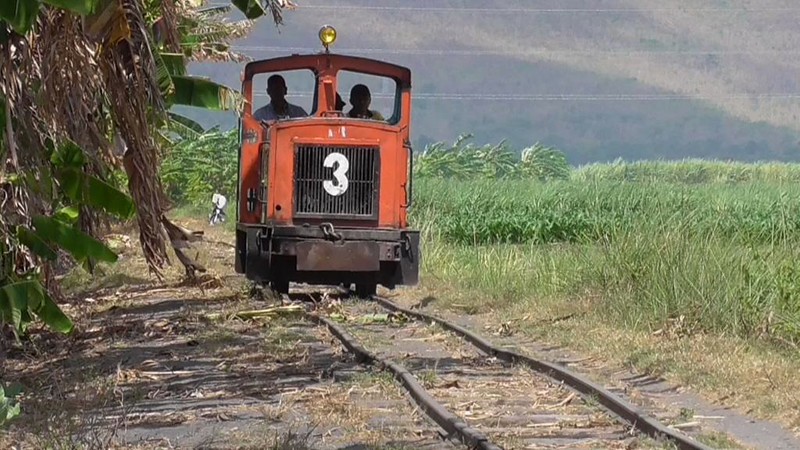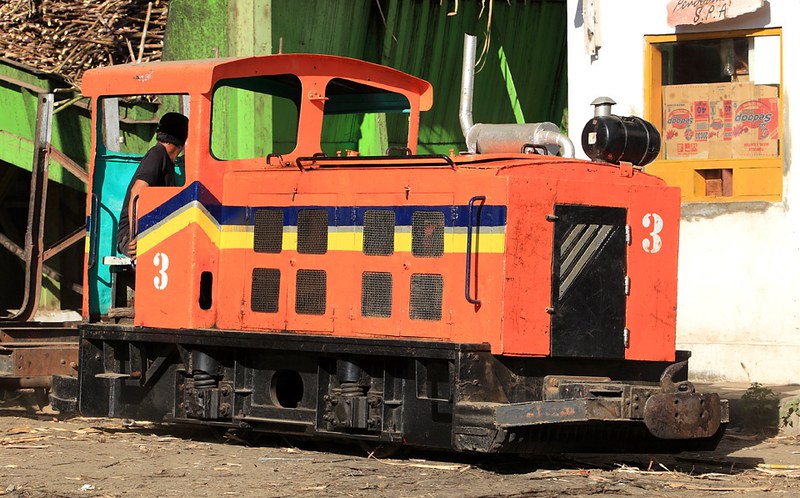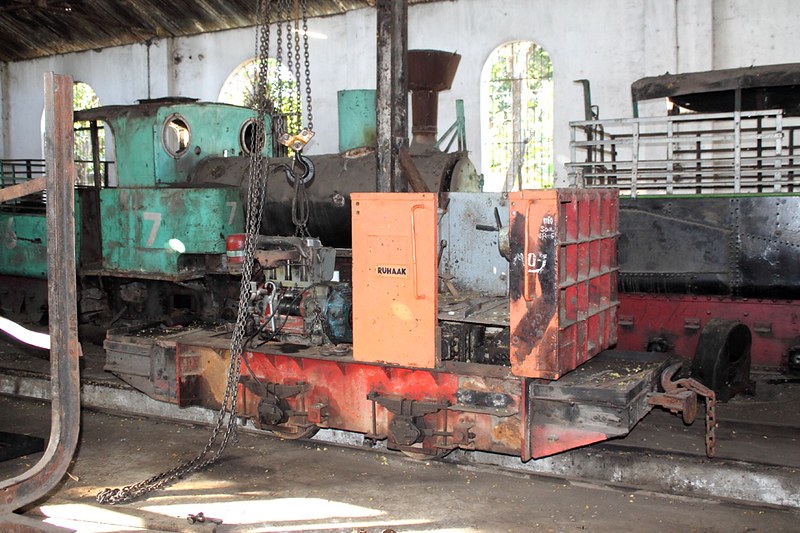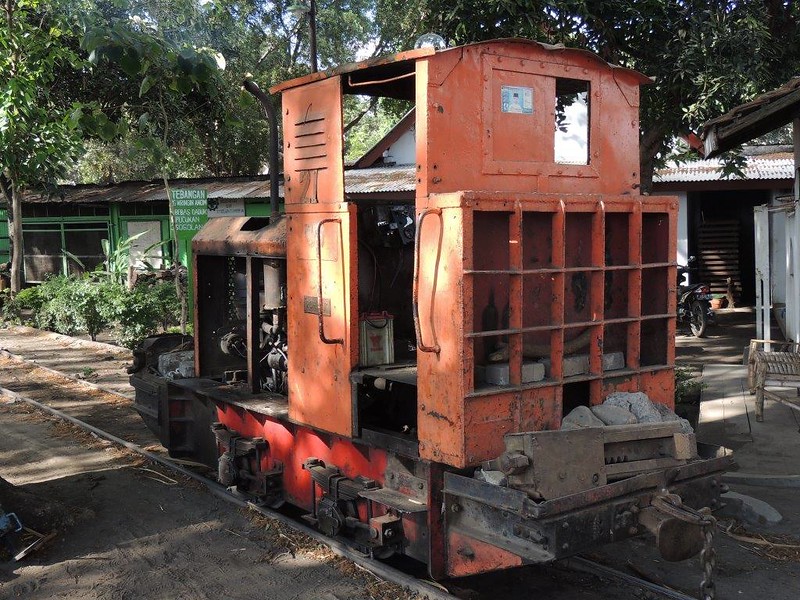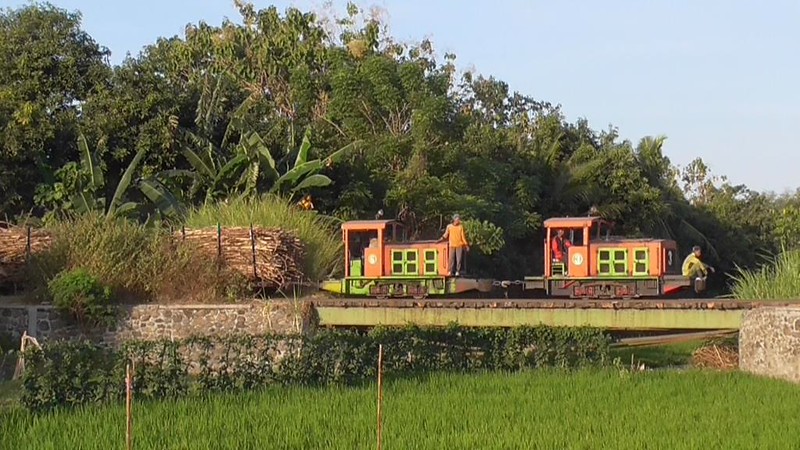Reports from Java during the 2014 Season Part 1
Java Sugar Mill Reports 2014
Linesiding with John
I won't be in Indonesia for the 2014 season so I am dependent on others for the information reported here. Three people have promised to send me occassional reports - thank you Chris, John A and Wilson. Chris is on the FarRail tour but John and Wilson are visiting separately and independently so we could have reports of up to 3 different visits to some major locations. I hope they will also include photos or video clips. More reports from visitors and local enthusiasts are most welcome and I will credit any information received to the sender. Here are a couple of photos from the 2012 season. In case it is not apparent, I'll use (JR) to show my own comments on the reports.
Pangka Mill in 2012.
A short walk around the corner from Pangka Mill is a small restaurant that Rob & I have used in the past. On the restaurant wall is a photo which goes back a few years. The staff and I enjoyed looking at it again. Visible from left to right are Mark, me, John B, Rod S, Peter G, Peter N, John A and Cliff along with some whose faces I don't remember and the friendly restaurant staff. If you are in this photo let me know. And those who went to Java only once may be able to date it. Which year was this?
Aditya comments:
I already updated the 2014 milling season reports to Rob Dickinson. He has been in touch with me and has been updating his site with my reports. So you can check out his site, and, you can ask him to forward my photos. I've also sent him photos of reports from Sumberharjo and Olean this year. Just prior to Eid, which is Monday next week, I will be going back to Situbondo to Wringinanom and Panji, and check out what's been happening there. I'll let you, and Rob Dickinson, keep up to date with this year's milling season.
You can see my latest photos on my flickr, which is https://www.flickr.com/photos/bad_boy_4_life/. The first few photos are taken very recently, and feel free to have them. Like I said, I already sent them to Rob Dickinson so you can ask him to forward them to you. And secondly, I live in Jember now, got a job at a state owned bank here, so it's just 2 hours down the road on a motorcycle to get to Situbondo, and only 1 hour on a motorcycle to get to Semboro and Jatiroto.
(JR) He has a point - Rob has been documenting steam in Java for many years. I've added a link to his page - top right. However, on this page I hope to capture a bit more of the personal side, a bit more of how people interact with the trains, the mills and the workers and daily life in Indonesia.
I already updated the 2014 milling season reports to Rob Dickinson. He has been in touch with me and has been updating his site with my reports. So you can check out his site, and, you can ask him to forward my photos. I've also sent him photos of reports from Sumberharjo and Olean this year. Just prior to Eid, which is Monday next week, I will be going back to Situbondo to Wringinanom and Panji, and check out what's been happening there. I'll let you, and Rob Dickinson, keep up to date with this year's milling season.
You can see my latest photos on my flickr, which is https://www.flickr.com/photos/bad_boy_4_life/. The first few photos are taken very recently, and feel free to have them. Like I said, I already sent them to Rob Dickinson so you can ask him to forward them to you. And secondly, I live in Jember now, got a job at a state owned bank here, so it's just 2 hours down the road on a motorcycle to get to Situbondo, and only 1 hour on a motorcycle to get to Semboro and Jatiroto.
(JR) He has a point - Rob has been documenting steam in Java for many years. I've added a link to his page - top right. However, on this page I hope to capture a bit more of the personal side, a bit more of how people interact with the trains, the mills and the workers and daily life in Indonesia.
Steve Noon writes:
I hope to get out to the fields sometime and if I do I will send some reports. Olean at least has steam out in the fields. Here in West Java the dry season does not seem very dry this year, so that may impact on the harvest and harvesting of the cane.
Attached is a pic from a couple of years ago at Sumberhardjo. I always find it a real challenge to make trains of empty lories look interesting (at least in still photos). In this case I spent most of the time trying to avoid those blasted wires getting in the way of my shots…..
I hope to get out to the fields sometime and if I do I will send some reports. Olean at least has steam out in the fields. Here in West Java the dry season does not seem very dry this year, so that may impact on the harvest and harvesting of the cane.
Attached is a pic from a couple of years ago at Sumberhardjo. I always find it a real challenge to make trains of empty lories look interesting (at least in still photos). In this case I spent most of the time trying to avoid those blasted wires getting in the way of my shots…..
(JR) I love this photo and I hope it gives an idea of the unusual Java 2014 milling season posts we could see here. Your contributions are most welcome!
Sumberharjo field train by Steve Noon
Four items below are based on a google search for Java Sugar Mills 2014. For each item, if you click on the box, it should take you to the website referred to for the full details.
Our train at Bedono at the top of the surviving rack section
Rack surfer following our train down the rack towards Jambu
(JR) I note that this loco has detail differences from the Wringinanom No. 3 I photographed in 2012- see above - but could be the same loco. No. 4 is clearly Wringinanom No. 4.
(JR) Photo clearly showing Wringinanom No. 3 is not the same loco as the new No. 3 at Olean. Does anyone know where the Olean loco came from?
(JR) Scott Jesser writes to say that No. 3 at Olean is Asembagus No. 3. For more on Olean, Asembagus and Wringinanom, see below.
Arif was at Olean on 22 June 2014 and found Asembagus No. 3 working there. He notes that the two Olean diesels are awaiting parts and that although 3 of the steam locos are in working order, only one of them is used at any time. He says that the diesel and steam situation is a cost saving measure imposed by head office,
Mark Hambly confirms that this photo was taken in 2010 on his only trip to Java.
(JR) Wilson found Wringinanom No. 8 on shunting duties today .
Wilson writes:
Wednesday 6 August
Am slowly covering John's Situbondo Heritage Walk but doubt whether I'll manage it in entirety as already it seems I haven't allowed enough time here. Yesterday I covered from the big bridge to the disused state railway line and today managed from Wringin Anom mill to the big bridge plus a short diversion up each of the two north lines.
Started the day with another quick look in the WA yard then headed out for some lineside shots. Five trains of empties headed away within an hour and a half: two for the south line, two onto the first north and one onto the second north.
Was going to spend the afternoon at the big bridge but decided it may be more fruitful between the mill and the first junction. Between 2.30 and 5.00 three inbound trains one of which was double headed and two light engine movements so reckon I made the right decision. The double header was not so much a case of two engines being coupled together as being tied together with some iron rope.
Thursday 7 August
The morning spent at Pradjekan. Found 3 & 4 by the molasses tanks with 3 on the molasses train and 4 on a short rake of cane wagons. After two molasses trains in quick succession the crossing keepers disappeared, I hung round for a bit but obviously nothing more was going to happen so headed back to Situbondo and a haircut. 10.000IRP…… a lot cheaper than at home but feel too many dark hairs removed with an excess of grey now remaining.
Afternoon back to WA for two loaded trains in and two light engines out. Delayed my return to Rosali in the hope of another double header but all that achieved was a walk home!
(JR) The first line north leads to the intermill connection to Olean.
Wednesday 6 August
Am slowly covering John's Situbondo Heritage Walk but doubt whether I'll manage it in entirety as already it seems I haven't allowed enough time here. Yesterday I covered from the big bridge to the disused state railway line and today managed from Wringin Anom mill to the big bridge plus a short diversion up each of the two north lines.
Started the day with another quick look in the WA yard then headed out for some lineside shots. Five trains of empties headed away within an hour and a half: two for the south line, two onto the first north and one onto the second north.
Was going to spend the afternoon at the big bridge but decided it may be more fruitful between the mill and the first junction. Between 2.30 and 5.00 three inbound trains one of which was double headed and two light engine movements so reckon I made the right decision. The double header was not so much a case of two engines being coupled together as being tied together with some iron rope.
Thursday 7 August
The morning spent at Pradjekan. Found 3 & 4 by the molasses tanks with 3 on the molasses train and 4 on a short rake of cane wagons. After two molasses trains in quick succession the crossing keepers disappeared, I hung round for a bit but obviously nothing more was going to happen so headed back to Situbondo and a haircut. 10.000IRP…… a lot cheaper than at home but feel too many dark hairs removed with an excess of grey now remaining.
Afternoon back to WA for two loaded trains in and two light engines out. Delayed my return to Rosali in the hope of another double header but all that achieved was a walk home!
(JR) The first line north leads to the intermill connection to Olean.
John Athersuch is now in place in Tegal for a visit to Pangkah Mill tomorrow. His report will appear here. Above is his photo of his transport from Jakarta.
Steve writes:
I was shocked to hear about Pandji closing its field lines. I always wanted to spend more time on that system, but thought I should prioritise other mills which seemed to be under more immediate threat of closure. Pandji always seemed more secure. However, on reflection hold-ups on the road crossings, as in so many other cases, probably did for it. I hope the irony is not lost on those who drive around these areas and are held-up by all the cane trucks clogging the roads! Also run-pasts of cane trucks are not very photogenic, even less photogenic than diesel locos pulling the cane!
Incidentally, I wonder whether any field lines survive at Pandji that do not cross the main roads (i.e. to the South and East)?
I have not heard any other shocking news from other mills (yet), but there is time. Indeed the rumours of the mill tramway being closed at Sragi seem to have been proved false (at least for this year).
The worst news seems to be from the Cape Gauge railways.
The rack section at Ambarawa is currently not operational (allegedly being renovated), and quotes for charters on the currently operational flat section to Tuntang have reached simply unbelievable and unpayable amounts of Rupiah. Clearly the railway 'bean counters' have done their sums and realized that the regular railway is cheaper to operate than the rack section. That is almost certainly true, but it seems that whoever is making these decisions knows everything about cost, but nothing about value! I think I may contact the President-elect about this. After all, as mayor of Solo he was instrumental in getting steam back into action there and I helped him source crucial spares to get the C12 operational! Clearly he is a potential uber-gricer!
Other bad news concerns Cepu where another bridge problem means that the ride is currently much shorter than usual. The last time this happened the lack of trains resulted in over a third of the track being stolen. It was replaced due to excellent leadership from the then acting President-Director of Perhutani (the State Forestry Company) who was also an enthusiast. She grew up in the forests and became a forest scientist, but never forgot her roots (ouch!) and loved the tramways. She even told me she would like to reinstate some of the lighter rails into the forest, and possibly some of the branches (ouch again!). I am not sure what is happening with the current management, but let's hope that law enforcement is better this time and no track disappears at the dead of night.
Still plenty to see across Java though!
I was shocked to hear about Pandji closing its field lines. I always wanted to spend more time on that system, but thought I should prioritise other mills which seemed to be under more immediate threat of closure. Pandji always seemed more secure. However, on reflection hold-ups on the road crossings, as in so many other cases, probably did for it. I hope the irony is not lost on those who drive around these areas and are held-up by all the cane trucks clogging the roads! Also run-pasts of cane trucks are not very photogenic, even less photogenic than diesel locos pulling the cane!
Incidentally, I wonder whether any field lines survive at Pandji that do not cross the main roads (i.e. to the South and East)?
I have not heard any other shocking news from other mills (yet), but there is time. Indeed the rumours of the mill tramway being closed at Sragi seem to have been proved false (at least for this year).
The worst news seems to be from the Cape Gauge railways.
The rack section at Ambarawa is currently not operational (allegedly being renovated), and quotes for charters on the currently operational flat section to Tuntang have reached simply unbelievable and unpayable amounts of Rupiah. Clearly the railway 'bean counters' have done their sums and realized that the regular railway is cheaper to operate than the rack section. That is almost certainly true, but it seems that whoever is making these decisions knows everything about cost, but nothing about value! I think I may contact the President-elect about this. After all, as mayor of Solo he was instrumental in getting steam back into action there and I helped him source crucial spares to get the C12 operational! Clearly he is a potential uber-gricer!
Other bad news concerns Cepu where another bridge problem means that the ride is currently much shorter than usual. The last time this happened the lack of trains resulted in over a third of the track being stolen. It was replaced due to excellent leadership from the then acting President-Director of Perhutani (the State Forestry Company) who was also an enthusiast. She grew up in the forests and became a forest scientist, but never forgot her roots (ouch!) and loved the tramways. She even told me she would like to reinstate some of the lighter rails into the forest, and possibly some of the branches (ouch again!). I am not sure what is happening with the current management, but let's hope that law enforcement is better this time and no track disappears at the dead of night.
Still plenty to see across Java though!
This part (Part 1) is an introduction and contains reports from Olean, Wringinanom and Pandjie (Panji) and other mills in passing.

